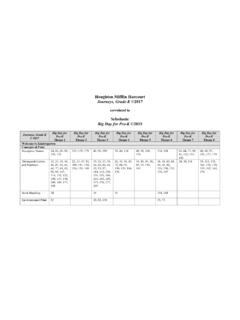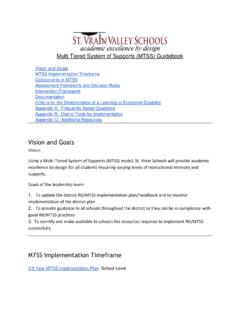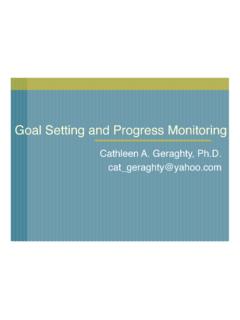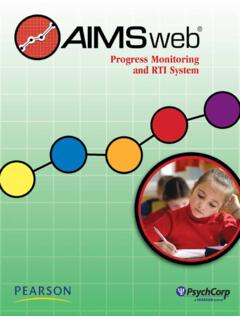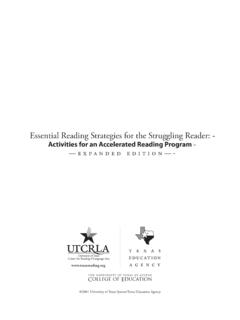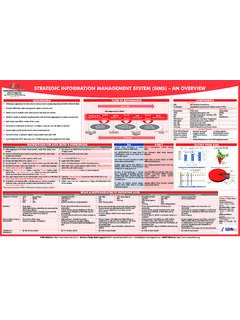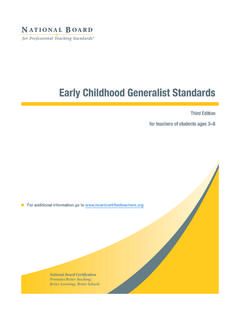Transcription of aimswebPlus Progress Monitoring Guide
1 Progress Monitoring GuideaimswebPlus | i | Progress Monitoring Guide For more information visit Copyright 2017 NCS Pearson, Inc. All rights reserved. Table of Contents Introduction .. 1 Foundations of Progress Monitoring .. 1 Deciding Which Students and Measures to Monitor .. 3 Performance 4 Instructional Tiers .. 5 Determining Intervention Needs, Kindergarten and Grade 1 .. 6 Determining Intervention Needs, Grades 2 Through 8 .. 7 Use With Learning Disability Qualification .. 9 Selecting the Grade Level of Monitoring Materials .. 10 Creating a Progress Monitoring Schedule .. 11 Step 1: Select a Baseline Score .. 11 Step 2: Select a Goal Date .. 12 Step 3: Set a Goal Score .. 12 Goal Setting With Individual Education Plans .. 13 Evaluating Progress .. 14 Case Studies .. 16 Case Study 1: Early Numeracy, Kindergarten, On-Grade.
2 16 Case Study 2: Early Literacy, Grade 1, Off-Grade .. 17 Case Study 3: Oral Reading Fluency, Grade 3, On-Grade .. 19 Case Study 4: Number Sense Fluency, Grade 6, Off-Grade .. 19 References .. 22 Appendix A: Student Growth Percentiles .. 23 Appendix B: Visual Analysis .. 25 Tables Table 1 Sequence of Early Literacy and Early Numeracy CBMs, by Grade and Season .. 7 Table 2 Common At-Risk Score Profiles and Recommendations for Next Steps, Reading .. 8 Table 3 Common At-Risk Score Profiles and Recommendations for Next Steps, Math .. 8 Table 4 Number Comparison Fluency Triads Item Counts, by Skill Area and Grade .. 21 Table 5 Mental Computation Fluency Item Counts, by Skill Area and Grade .. 21 Figures Figure 1 Benchmark Comparison Screen .. 3 Figure 2 Oral Reading Fluency National Norms Table, Grade 2 .. 9 Figure 3 Survey Level Assessment Screen.
3 11 aimswebPlus | ii | Progress Monitoring Guide For more information visit Copyright 2017 NCS Pearson, Inc. All rights reserved. Table of Contents cont. Figures cont . Figure 4 Progress Monitoring Screen, Baseline Scores .. 12 Figure 5 Progress Monitoring Screen, Target Week & Monitor Frequency .. 12 Figure 6 Progress Monitoring Screen, Goal Score .. 13 Figure 7 Sample Progress Monitoring Score Graph, Oral Reading Fluency .. 15 Figure 8 Progress Monitoring Score Graph at Week 6, Case Study 1 .. 17 Figure 9 Progress Monitoring Score Graph at Week 12, Case Study 1 .. 17 Figure 10 Survey Level Assessment Scores, Case Study 18 Figure 11 Progress Monitoring Score Graph at Week 7, Case Study 2 .. 19 Figure B1 Projection Line With Outlier .. 25 Figure B2 Projection Line With Outlier Removed .. 25 Figure B3 Projection Line With Nonlinear Pattern of Score Growth.
4 26 Figure B4 Score Pattern With Low Variability .. 26 Figure B5 Score Pattern With High Variability .. 27 aimswebPlus | 1 | Progress Monitoring Guide For more information visit Copyright 2017 NCS Pearson, Inc. All rights reserved. Introduction aimswebPlus is an assessment, data management, and reporting system that provides national and local performance and growth norms for the screening and Progress Monitoring of math and reading skills for all students in Kindergarten through Grade 8. aimswebPlus uses two types of measures: curriculum-based measures (CBMs) brief, timed measures of fluency on essential basic skills and standards-based assessments (SBAs), which are comprehensive measures aligned to current learning standards. By combining these two types of measures, aimswebPlus provides the data that schools need for program planning and evaluation and for tiered assessment (multi-tiered system of supports [MTSS], also known as response to i ntervention [RTI]).
5 aimswebPlus data provide the information needed to differentiate instruction and determine who will benefit from intensive intervention. Progress Monitoring the frequent and ongoing collection of information about student performance is an essential component of a tiered assessment system . By collecting such data, a student s rate of improvement can be compared to expected growth to determine if adequate Progress is being made toward end-of-year goals or if changes to instruction are needed to improve student growth. In this Guide , the foundations of Progress Monitoring are first discussed, followed by sections on identifying which students to Progress monitor, selecting the measure(s) to monitor and the appropriate grade level of Monitoring materials, and creating a Progress Monitoring schedule. Next, case studies are presented to illustrate Progress Monitoring within the aimswebPlus system .
6 Finally, information regarding student growth percentiles and conducting a visual analysis of Progress Monitoring data are presented in Appendixes A and B, respectively. Foundations of Progress Monitoring The Individuals with Disabilities Education Act (IDEA, 2004) and the Every Student Succeeds Act (ESSA, 2015) require schools to evaluate the effects of evidence-based instruction, a task for which RTI is ideally suited. Monitoring each student s response to intervention enables teachers to gauge the effectiveness of the core curriculum and to align resources with student needs. Studies indicate that using Progress Monitoring to Guide instruction improves student achievement, especially for students with low achievement and those with disabilities, when qualified professionals implement the following program features (Black & Wiliam, 1998; Fuchs & Fuchs, 1986.)
7 Stecker, Fuchs, & Fuchs, 2005): Collect data frequently Display and review data graphically Create explicit decision rules for when to continue or modify instruction Implement data collection and decision rules with integrity Provide clear direction for instructional modifications and alternatives The aimswebPlus system supports accurate and frequent data collection, automatically displays results and trends via graphs, projects growth trends alongside growth expectations, and provides explicit rules for deciding whether a student is on or off track to meet his or her end-of-year goals. Note that the last feature of effective Progress Monitoring , providing direction on how to modify or replace instructional interventions, is beyond the scope of this Guide . Progress Monitoring can help to determine if an instructional program is effective, but it cannot identify potential alternatives.
8 aimswebPlus | 2 | Progress Monitoring Guide For more information visit Copyright 2017 NCS Pearson, Inc. All rights reserved. The aimswebPlus approach to frequent Progress Monitoring relies on curriculum-based measurement, a method that is standardized, valid, reliable, repeatable, simple, efficient, inexpensive, and sensitive to achievement growth over relatively brief intervals (Deno, 1986). Curriculum-based measures (CBMs) assess foundational skills that are the basis for success on higher-order, complex skills. With appropriate instruction, basic skills can rapidly develop and this development will be represented by improved student performance on CBMs. These characteristics make CBMs ideally suited to the frequent assessment that is required for Progress Monitoring programs (Deno, 1985, 2003). Together, triannual screening and Progress Monitoring link expectations ( , benchmarks) and performance levels ( , norms) to individual student goals.
9 The aimswebPlus standards-based assessments (SBAs) measure the higher-order thinking skills and conceptual knowledge defined in current learning standards. SBAs include reading comprehension, vocabulary knowledge, and math concepts and applications. Although students may have deficits in any one of these domains, frequent Progress Monitoring on these specific content areas is not recommended because complex, higher-order thinking skills develop more slowly than foundational skills and reliable assessment of these complex skills requires more testing time than is reasonable on a weekly basis. As such, the Concepts & Applications and Reading Comprehension measures are not available for weekly Progress Monitoring . Real growth that is, growth that is reliably greater than zero on a standardized assessment in these domains typically takes several months of intervention to detect.
10 One of the benefits of triannual interim assessment ( , benchmarking) is that data can be used to identify growth in these domains without waiting an entire school year for end-of-year assessment results. These triannual, standards-based assessments can also be supplemented with unit quizzes, practice problems, and/or mastery Monitoring methods widely available in reading and math intervention systems. Within an RTI system , student performance is organized into three tiers. Students in Tier 3 typically need intensive intervention to build skills and deepen their understanding of learning standards taught in the core instructional program. Students in Tier 2 may need only small-group instruction and additional practice on core content to get on track. Students in Tier 1 are expected to stay on track with high quality, research-based core instruction.
